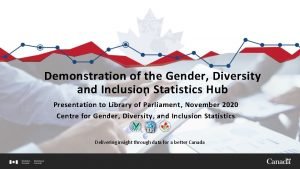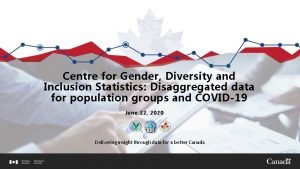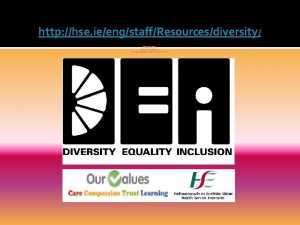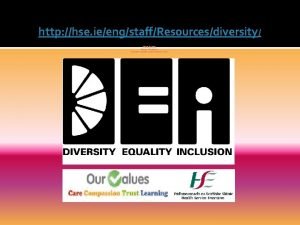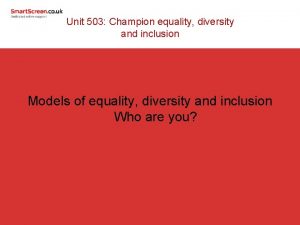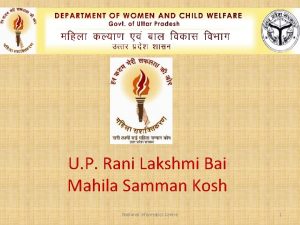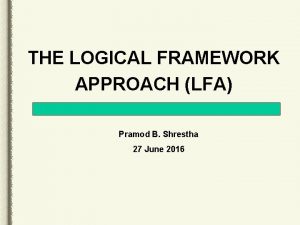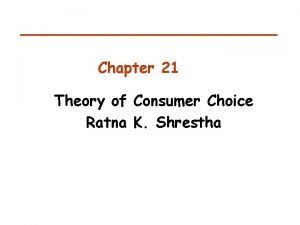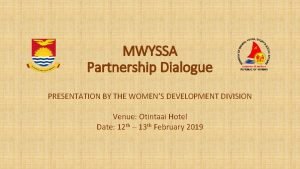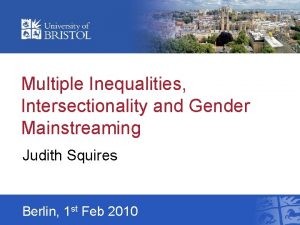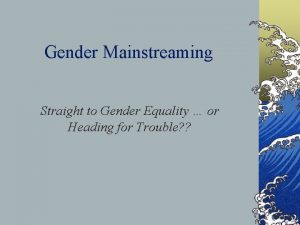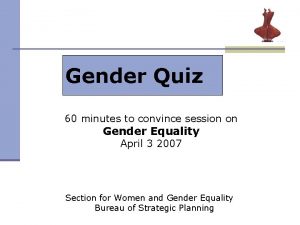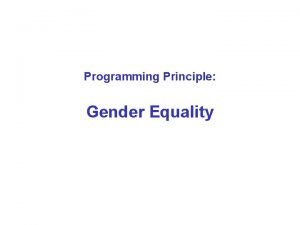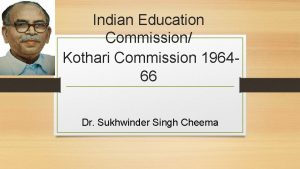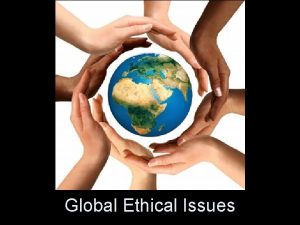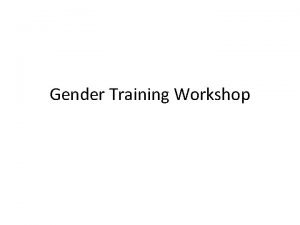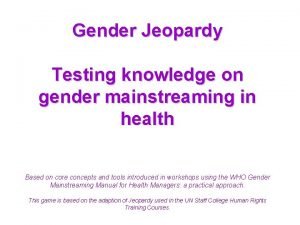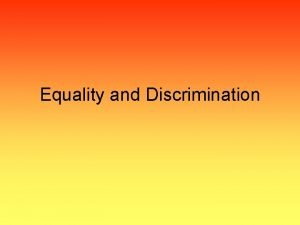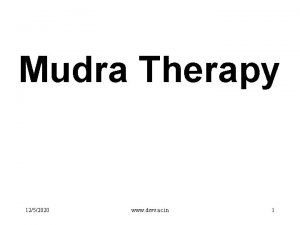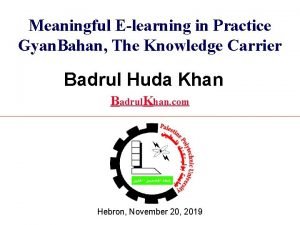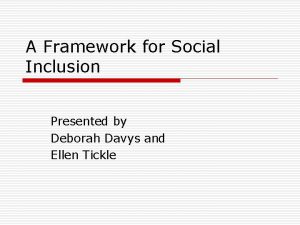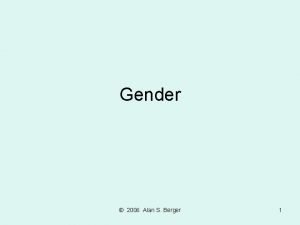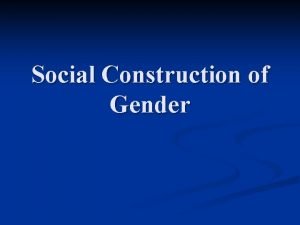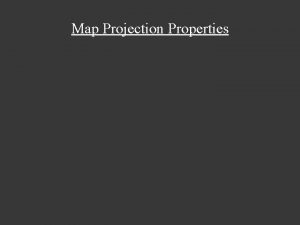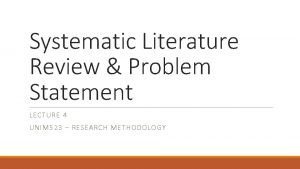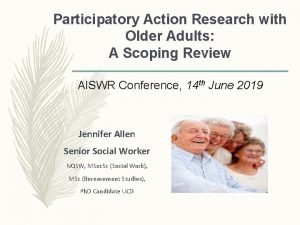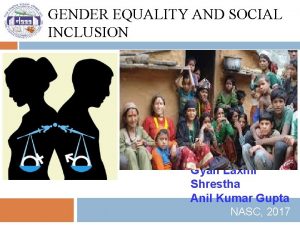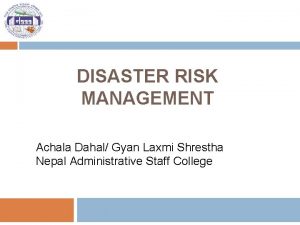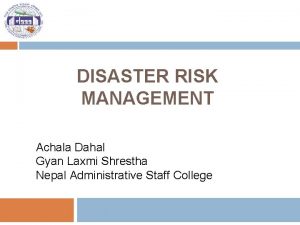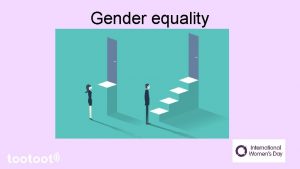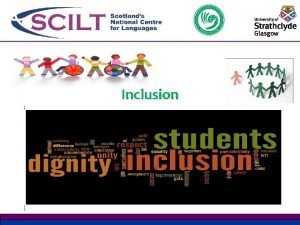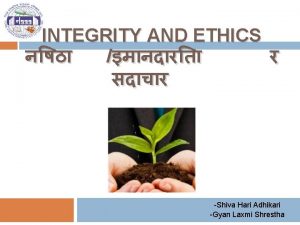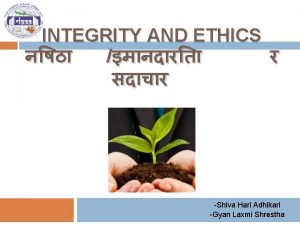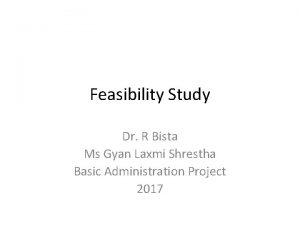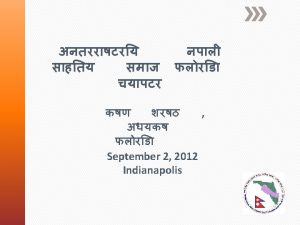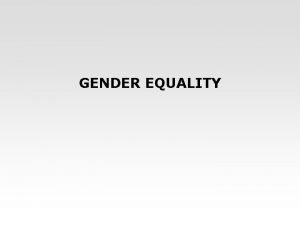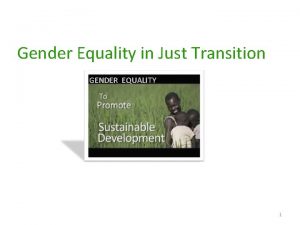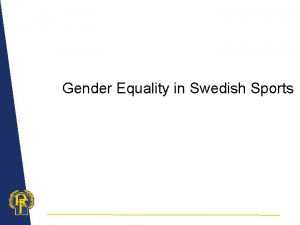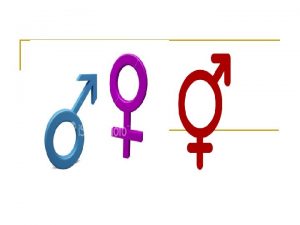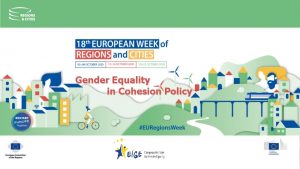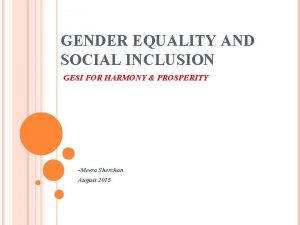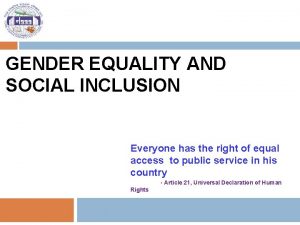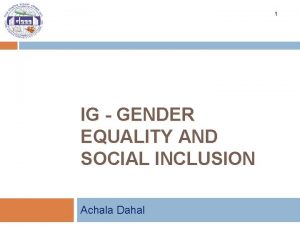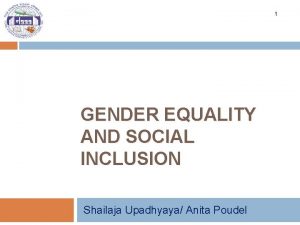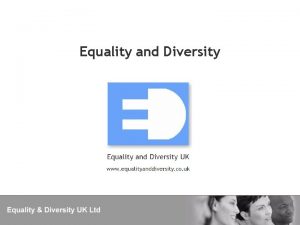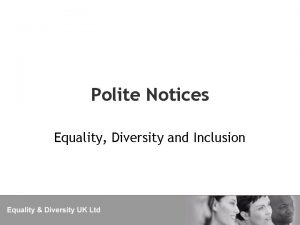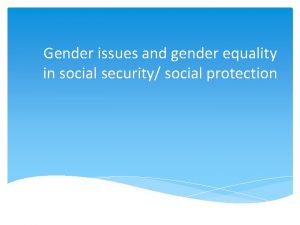GENDER EQUALITY AND SOCIAL INCLUSION Gyan Laxmi Shrestha



![कथ : 4 Pp 6 f sf/df afa' / 5 f]/f ofqf ul//x]sf ly. कथ : 4 Pp 6 f sf/df afa' / 5 f]/f ofqf ul//x]sf ly.](https://slidetodoc.com/presentation_image_h2/3b7546b730a6558051d8e5c1300a0dce/image-4.jpg)




![tnsf lrqdf s]] le. Ggtf b]Vg'x'G 5 < 9 tnsf lrqdf s]] le. Ggtf b]Vg'x'G 5 < 9](https://slidetodoc.com/presentation_image_h2/3b7546b730a6558051d8e5c1300a0dce/image-9.jpg)






























- Slides: 39

GENDER EQUALITY AND SOCIAL INCLUSION Gyan Laxmi Shrestha NASC, 2017

Coverage 2 Social Inclusion Exploring gender discrimination in Nepal (Video) Gender equality and social inclusion Dimensions of Exclusion GESI as an approach and Why GESI Issues and challenges GESI in Institutions Efforts taken by GON Way Forward

EXERCISE: Draw pictures 3 - Boy Girl Police man Nurse Pilot Driver - - Conductor Doctor Primary level Teacher Professor
![कथ 4 Pp 6 f sfdf afa 5 ff ofqf ulxsf ly कथ : 4 Pp 6 f sf/df afa' / 5 f]/f ofqf ul//x]sf ly.](https://slidetodoc.com/presentation_image_h2/3b7546b730a6558051d8e5c1300a0dce/image-4.jpg)
कथ : 4 Pp 6 f sf/df afa' / 5 f]/f ofqf ul//x]sf ly. P. sf/ b'3{6 gfdf k¥of]. p. Qm b'3{6 gfdf afa' ; fdf. Go 3 f. Ot] dfq e. Psf] lyof] t/ 5 f]/f] eg] ul. De/ cj: yfdf lyof]. 3 f. Ot] b'j} d. Wo] t. Tsfn pkrf/sf nflu 5'66 f 5'6} c: ktfndf egf{ ul/of]. ha 5 f]/fnf. O{ c: ktfn egf{ ul/of] / 8 f. S 6/n] hf. Fr ug{ yf. Nof], ta 8 f. S 6/n] e. Gof] ls d o; sf] pkrf/ ug{ ; l. Sbg lsgls ऊ d]/f] 5 f]/f xf]. ca e. Gg'xf]; 8 f. S 6/ / 3 f. Ot] a. Lr s] ; Da. Gw /x]5 < �������

5


SOCIALIZATION 7 Socialization is the result of traditions, societal values and beliefs. It is the process by which we learn norms, customs, and ideologies of our own society. Rules, practices, division of labor, social expectations; vulnerability and mobility conditions differ for women, people of different social groups (ethnic minority/majority, income groups and of different geographical locations). We need to reflect on how different cultural, social, religious norms direct and dictate acceptable behaviour and attitude towards people of different genders and social groups.

8
![tnsf lrqdf s le Ggtf bVgxG 5 9 tnsf lrqdf s]] le. Ggtf b]Vg'x'G 5 < 9](https://slidetodoc.com/presentation_image_h2/3b7546b730a6558051d8e5c1300a0dce/image-9.jpg)
tnsf lrqdf s]] le. Ggtf b]Vg'x'G 5 < 9

Mind sees what it chooses to see 10 GENDER AND INCLUSION : WE SEE WHAT WE ARE SHOWN (MOSTLY) AND IT BECOMES NATURAL

Poverty -GESI) Geographic -GESI) Multiple & Cross-cutting Exclusions Gender Social Identity: Ethnicity, Caste, Regional, Religion

EXCLUDED GROUPS 12 Economically Excluded Poor of All ● Caste ● Location ● Ethnicity ● Sex ● Women ● Dalits ● Adibasi ● Madhesis Janajatis ● Muslims ● People with disabilities ● People of geographically remote areas ● Sexual and Gender Minorities Socially Excluded (specific issues of exclusion)

VULNERABLE GROUPS 13 People are “vulnerable” rather than “excluded” when deprivations are a result of a particular situation (in some cases only temporary) that has reduced their ability to withstand shocks rather than their more deeply Example: People Living In Areas Affected By Earthquakes, Floods Or Drought HIV AIDs-affected People Sex Workers And Trafficked People Children, Adolescents, Older People

14

Contd. . 15

16 Exploring Gender Discrimination in Nepal Video Case Discussion

Exercise 17 Being a public service provider, what do you think are your responsibilities for the realization of existence of inclusive governance/GESI by the service receiver? 10 minutes NASC 2015

Dimension of Inclusion/Exclusion 18 Inclusio n Exclusion Gender Caste/Ethnici Economically Disability ty Geographical ly and so on Gender Gender Caste/Ethnicit y Caste/Ethnicit y Economically Economically Disability Disability Geographicall y Geographicall y

GESI 19 GESI is an approach that brings women and men from all social groups (ethnicity, caste, economy, age, disability, geographic locations) in all political, economic and social spheres It aims to promote gender equality and social inclusion by addressing existing disparities and gaps in access and control over resources, services, information and opportunities and the distribution of power and decision making

Why GESI 20 An overwhelming number of citizens are systematically deprived of their fundamental human rights and their rights to development Undertaken as new development intervention to overcome the obstacles of gender inequality and social exclusion Focused on key issues that hinder women, poor and socially excluded group in the participation and benefit sharing

Contd. . 21 Acting as a significant role to narrow down the existing gaps between women and men belonging to various social groups Develop and maintain a positive, respectful work culture that ensures equity and diversity for all employees and is free from discrimination Create a peaceful, harmonious and a coherent society

Issues 22 GESI Issues Women equity, equality, empowerment, Mainstreaming, participation and so on. Janjatis/ Adiwashi Culture, Language, Recognition and so on. Madheshi Identity, Mainstreaming and so on Muslim Religion, Minority, Poverty and so on. Dalits Poverty, Untouchability and so on. Remote and marginalized areas Economic and Infrastructural Development and so on. Senior Citizen, children, Social protection

Challenges 23 The effective implementation of GESI provisions in policies, programmes and guidelines Multi-sectorial coordination to address issues of women, poor and excluded people Identifying the income poor Regular opportunities to strengthen service providers’ skills to meet their duties and strength capacity of service receiver to claim their right

GESI in Institutions 24 G disa ESI (qua ggregate ntita d t i v e an qual d itativ e) data base syste m GESI ive s n o p res licy o p R H GESI responsive policy, strategy, programme, rule, regulation and budget Institutions e and g d e l w o n K arers e b y t u d f skill o to SI deliver GE e responsiv services I GES ive t i s n se ion t a z i organ (code re cultu duct) n of co Affirm ative a ction on rec ognitio n and su for the bsidy target ed popula tion

Inequality Underlying Socio-cultural Institutions, Values & Codes of Behavior 25 Assets & Capabilities Inequitable distributional rules Civil Society, Private Sector & Public Sector INSTITUTIONS Lots of assets & capabilities e ELITES MIDDLE ng o r t Inf c en lu e S ea Few assets or capabilities POOR & SOCIALLY EXCLUDED W k In fl nc e u

Equality Social Inclusion: 26 Assets & Capabilities “Removal of institutional barriers and enhancement of incentives to increase access of diverse individuals and groups to development. ” More equitable distribution rules INSTITUTIONS Elites Middle POOR Pa rtn er f Ch or sh ip an ge

27 Efforts taken by Government The concern on women was first surfaced in the sixth plan(1981 -85) Ninth plan (1997 -2002) adopted three pronged strategies to empower women namely mainstreaming, eliminating gender inequality and empowerment Tenth Five-Year Plan (2002– 2006) – also known as the Poverty Reduction Strategy Paper (PRSP) – which declared ‘social inclusion’ to be one of the four pillars on which to focus. Chapter 26 of this plan outlines the need for gender equality to achieve the

Contd. . 28 The Three-Year Interim Plan (2007– 2010) has a separate section for women’s fundamental rights and more inclusive toward Dalits, Madhesis, indigenous groups and persons with disabilities The 1990 Constitution accepted the notion of Inclusive Governance and made special provisions for ensuring inclusive participation of women, Dalits, marginalised and oppressed communities in national governance processes

Contd. . 29 Interim Constitution of Nepal (2007) included provisions to support gender equality and social inclusion Under Article 18 relating to the Right to Equality states that: “No discrimination shall be made against any citizen in the application of general laws on grounds of religion, race, sex, caste, tribe, origin, language or ideological conviction or any of these. ” Article 20 guarantees right of women Article 21 assurances right to social justice

2072 Constitution of Nepal 30 Preamble “Ending all forms of discrimination and oppression created by the feudalistic, autocratic, centralized, unitary system of governance. Protecting and promoting social and cultural solidarity, tolerance and harmony, and unity in diversity by recognizing the multi-ethnic, multi-lingual, multi-religious, multi-cultural and diverse regional characteristics, resolving to build an egalitarian society founded on the proportional inclusive and participatory principles in order to ensure economic equality, prosperity and social justice, by eliminating discrimination based on class, caste, region, language, religion and gender and all forms of caste-based untouchability”

Contd. . 31 Right to equality: Article 18 Right against untouchability and discrimination: Article 24 Right to language and culture: Article 32 Right of women: Article 38 Right of Dalits: Article 40 Right to social justice: Article 42 Right to social security: Article 43

Institutional Developments 32 In 1995, the Ministry of Women, Children and Social Welfare was established In 1997, the National Committee for the Development of Nationalities and the Committee for Upliftment of Downtrodden, Oppressed and Dalit Classes were established In 2002, the National Foundation for Development of Indigenous Nationalities was institutionalized with necessary reforms

Contd. . 33 The National Women Commission and the National Dalit Commission was established in 2002 to integrate social inclusion into national governance agenda and strengthen capacity In 2004, formed high-level Committee on Reservation to recommend appropriate policy, mechanism and procedures for effective enforcement of reservation system, as part of affirmative action, for inclusive representation of women, Dalits and indigenous nationalities in the public service of Nepal

34

Way forward 35 Affirmative action and positive discrimination to the targeted groups Coordinate and collaborate with local bodies, line agencies, social leaders and media GESI capacity building of the stakeholders and partners at all levels and create platform for GESI Adopt right based approach to reach poor women and men, and women belonging to janjati, dalit, madhesi, muslim and other backward communities Revising and planning from the lessons learned and up-scaling of the good practices.

36 When I was born, A women was there to hold me……My Mother. As I grew up as a child, A women was there to care and play with me…. . My Sister. I went to school, A women was there to help me learn…. . My Teacher. I became depressed when I lost, A women was there to offer a shoulder…My Girlfriend. I needed compatibility, company and love, A women was there for me…. My Wife. I became tough, A women was there to melt me……My Daughter. When I will die, A women will be there to absorb 5/18/2021 NASC 31 th BAT-IG

37 Changing MY OWN positive ATTITUDE on GESI is key way to achieve harmony & prosperity in Society

Conclusion 38 The civil service of Nepal needs to act on concept of inclusive governance and GESI in order to ensure the rights of every citizens and become accountable and responsive towards the need of every citizen without discrimination in all development processes

39 Thank you
 Centre for gender diversity and inclusion statistics
Centre for gender diversity and inclusion statistics Centre for gender diversity and inclusion statistics
Centre for gender diversity and inclusion statistics Hse diversity equality and inclusion strategy
Hse diversity equality and inclusion strategy Hse diversity equality and inclusion strategy
Hse diversity equality and inclusion strategy Unit 503
Unit 503 Strategic gender needs and practical gender needs
Strategic gender needs and practical gender needs Rani laxmi bai mahila samman kosh
Rani laxmi bai mahila samman kosh Sezma
Sezma Pramod shrestha
Pramod shrestha Dr rajendra shrestha
Dr rajendra shrestha Sezma shrestha
Sezma shrestha Chapter 21 the theory of consumer choice
Chapter 21 the theory of consumer choice Mwyssa
Mwyssa Rhetorical questions about gender equality
Rhetorical questions about gender equality Gender equality definition
Gender equality definition What is gender equality answer
What is gender equality answer Methodology of gender equality
Methodology of gender equality Kothari commission report
Kothari commission report Gender equality poem tagalog
Gender equality poem tagalog Example of gender equality
Example of gender equality Slogan about discrimination
Slogan about discrimination Claudia padovani unipd
Claudia padovani unipd Substantive equality vs formal equality
Substantive equality vs formal equality Formal and substantive equality
Formal and substantive equality Gyan vahini
Gyan vahini Gyan sys
Gyan sys Mudra
Mudra Gyan ki bahan
Gyan ki bahan Social inclusion framework
Social inclusion framework Fise
Fise Social inclusion framework
Social inclusion framework Gender and social stratification
Gender and social stratification Are gender roles a social construct
Are gender roles a social construct N-gendrer
N-gendrer Organization of cartographers for social equality
Organization of cartographers for social equality Social thinking adalah
Social thinking adalah Social thinking social influence social relations
Social thinking social influence social relations Example of statement of the problem
Example of statement of the problem What is inclusion and exclusion
What is inclusion and exclusion What is the inclusion and exclusion criteria in research
What is the inclusion and exclusion criteria in research
